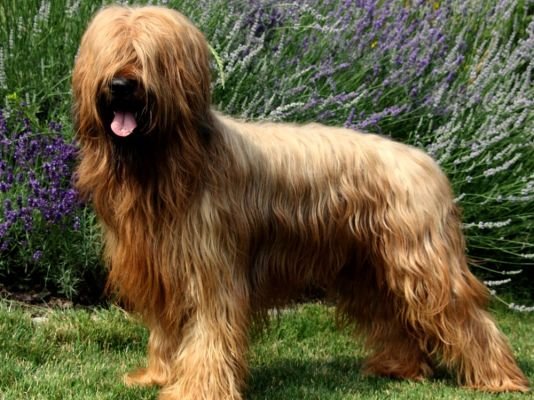





Meet the Briard: France’s Majestic Guardian with a Lion’s Mane
Imagine a dog that looks like a lion crossed with a sheepdog—voilà, that’s the Briard! Hailing from the French countryside, this bold, shaggy-coated herder has guarded flocks, marched with Napoleon, and charmed families worldwide. But before you fall for those soulful eyes and flowing locks, let’s unpack what makes this breed both a loyal protector and a high-maintenance companion.
Quick Snapshot
| Trait | Briard |
|---|---|
| Height | 23–27″ (58–68cm) ♂/♀ |
| Weight | 79–88 lbs (36–40kg) ♂ / 60–68 lbs (27–31kg) ♀ |
| Lifespan | 8–10 years |
| Coat | Thick, wavy double layer; black, fawn, or gray |
| Energy Level | High (2+ hours/day) |
| Barking | Moderate (alert watchdog) |
Looks & Grooming: The Fluffy Frenchman
Think “lion meets sheepdog”:
- Signature Style: A dense, slightly wavy double coat that can grow over 3 inches long—perfect for braving chilly French winters. Those “goat-like” hairs aren’t just for looks; they repel dirt and moisture.
- Grooming 101: Brush 2–3 times weekly to prevent mats (a slicker brush is your best friend!). Trim paw fur to avoid mud clumps. Baths every 6–8 weeks with a gentle shampoo. Pro tip: Check ears weekly—those fluffy flaps trap moisture!
- Bonus Feature: Their coat changes texture with age—puppies have softer fur that coarsens over time.
Fun Fact: Briards have double dewclaws on their hind legs—a breed hallmark. Missing one? It’s a disqualification in shows.
Personality: Bold Protector, Gentle Soul
This breed’s a mix of 60% “fierce guardian” and 40% “family shadow”:
- Kid-Friendly? Yes, but they’ll try to herd toddlers like sheep! Best with older children who respect their space.
- Stranger Alert: Wary of newcomers but rarely aggressive. Early socialization is key—introduce them to mail carriers, joggers, and skateboards!
- Mind Games: Boredom = dug-up flower beds. Keep them busy with puzzle toys or agility courses.
Training Tip: Use calm confidence, not force! They respect firm leaders but rebel against harsh methods. Start obedience training at 8–10 weeks—never skip this!
Pros & Cons
| Pros | Cons |
|---|---|
| Low-shedding coat (great for mild allergies) | Daily brushing marathons required |
| Natural protector (instincts intact!) | Prone to bloat (feed 2–3 small meals/day) |
| Thrives on outdoor adventures | Not for apartment dwellers or couch potatoes |
Health & Nutrition
Diet Essentials:
- Adults: 3–4 cups high-protein kibble (30%+ meat) for muscle/joint health. Glucosamine supplements recommended for hips.
- Snack Hack: Frozen carrots (low-cal + teeth cleaning!). Avoid grains—common allergy trigger.
- Watch For: Hip dysplasia (ask breeders for OFA certifications) and progressive retinal atrophy. Annual vet checks are non-negotiable.
Exercise Musts:
- Morning: 45-minute hike or herding drills (they love mimicking their ancestral jobs!).
- Evening: Interactive games like hide-and-seek with treats.
Spotting a Healthy Pup
| Trait | Healthy Pick | Red Flags! |
|---|---|---|
| Eyes | Bright, almond-shaped | Cloudiness or squinting |
| Movement | Springy, no limping | Stiff hips or reluctance to jump |
| Temperament | Curious but calm | Extreme shyness or aggression |
Ethical Breeder Checklist:
- Health clearances: Hips (OFA), elbows, eyes.
- Meet both parents—should be confident, not skittish.
- Puppies raised in home environments (exposed to vacuum cleaners, doorbells).
Final Thought
The Briard isn’t just a pet—it’s a living piece of French history. Perfect for active families craving a hiking buddy who’d face a wolf for you. Skip if you’re low on time or patience… but if you’re ready for a dog that’s equal parts noble guardian and shaggy comedian, this breed’s magnifique!
P.S. Rescue alert! Check European herding dog rescues—some retired Briards need homes after their owners underestimated their energy. Adopting one? That’s giving a Gallic legend a second act!


